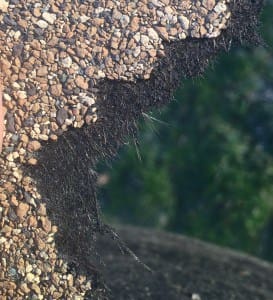Shingles are made from 3 layers. Each of them plays a role in protecting your home.

This closeup of a torn shingle shows the threads of the fiberglass, the asphalt matting and the protective granules.
Matting
The matting is the base layer from which all else is built upon. Think of it like the foundation of a house. If the foundation is good, a good builder can build up from there. If not, well, the product will fail.
Matting has been made of primarily two materials — cellulose (think tar paper or cardboard) and now fiberglass. Fiberglass overtook cellulose a few decades ago. Rather than relying on saturating cellulose with costly asphalt, most manufacturers now apply the asphalt directly onto the fiberglass.
Asphalt
This is the center layer of all asphalt shingles and it is what protects your home from getting water in it. It’s the black, tarry substance that repells water.
Granules
When you look at a roof, the color that you see is the color of the protective granules. These granules are embedded into the asphalt in order to protect the asphalt from heat and UV rays breaking down and drying out the asphalt. Some manufacturers boast that they press extra granules into their asphalt shingles and therefore the homeowner should expect a certain normal amount of sloughing off of granules in the first two years after a roof is installed. There’s a certain logic to this, but at the same time, at the end of the lifespan of a roof, granules break loose as the asphalt underneath them breaks down and is unable to hold the granules tight. Therefore, sloughing is most frequent at the beginning of the lifespan of your roof and at the end.

